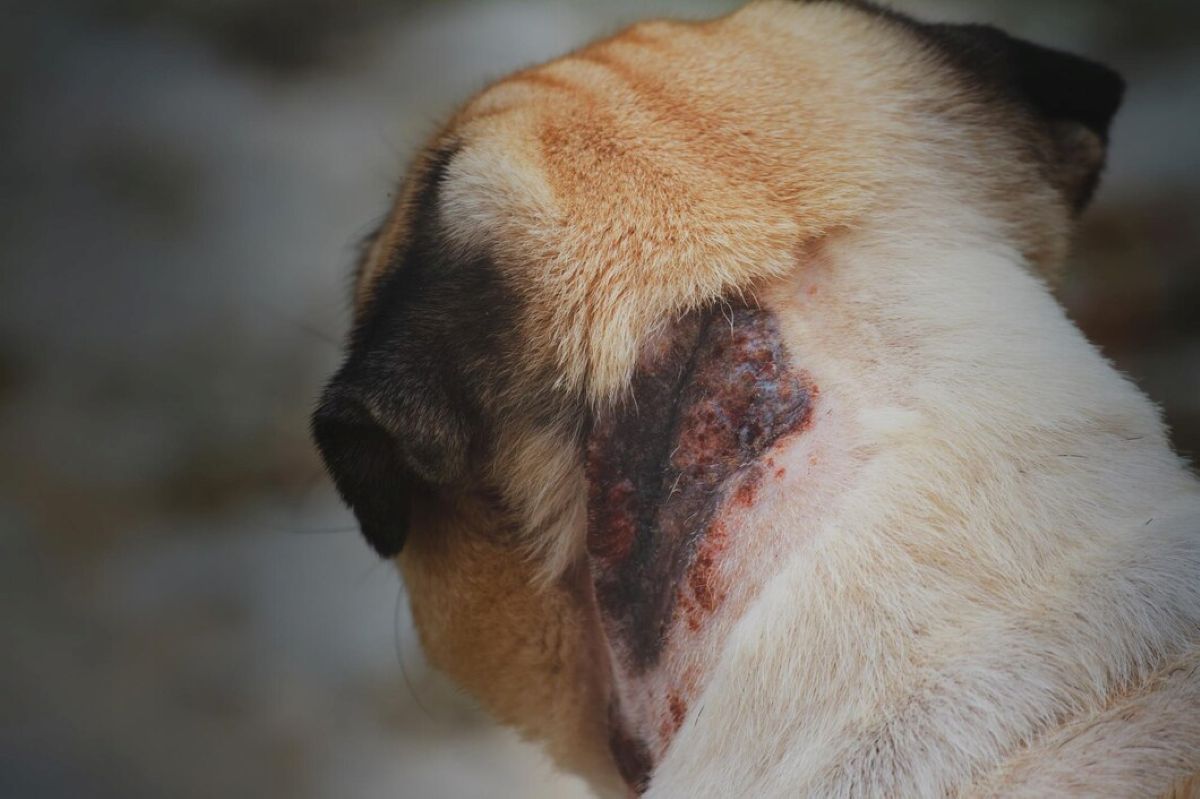Keep your dog’s skin healthy!
A dog’s fur is not the only thing that makes your dog beautiful. Its skin is an essential factor is your dog having a beautiful coat. When their skin is irritated by something, your dog might start feeling uncomfortable and its skin might become red and itchy. Fur loss might also occur in some cases. Fortunately, most dog skin problems, such as allergies or acne, can be successfully treated with the proper treatment, of course. If you notice something unusual on your dog’s skin, go to the vet for a proper medical examination.
To be more informed as to what skin conditions mean when it comes to your furry friend, check out these 14 most common skin problems and how to treat them efficiently, as advised by veterinarians.

Allergies
“Skin that appears red, inflamed, or irritated could signal an allergic reaction or infection,” explains Nicole Savageau, a veterinarian with The Vets. Some dogs may have reactions to proteins in foods, such as chicken, beef, lamb or eggs. Others may be affected by substances you use around the house, such as pesticides, or they may even be allergic to synthetic or wool materials.
Diagnosis
According to Dr. Savageau, the easiest way to determine if your dog is allergic to something, is to perform skin prick tests or blood tests. Also, if there is a suspicion regarding some sort of food allergy, you might want to implement an elimination diet for your dog, to determine the cause, step by step.
Treatment
Medication does not always do the trick when it comes to allergies. However, if you succeed in identifying the culprits in the case of your dog, try to eliminate them or reduce your dog’s exposure to them.
For example, if your dog has certain reactions to chicken, opt for chicken-free food. Consequently, if your dog is allergic to certain materials, such as wool, don’t use this type of material when it comes to your dog’s belongings, such as its bed.
Dermatitis
According to pet experts, around 10 to 15% of dogs are affected by atopic dermatitis. One common symptom is aggressive itchiness. This might make your dog want to scratch, lick and tend to the affected spots, causing redness and irritation to the skin.
Diagnosis
Unfortunately, in the case of atopic dermatitis, there is no universal cure. You have to try various treatments to see what works for your dog; also, it is important for the vet to check for parasites.
Treatment
Most vets recommend a combination treatment. This might include baths in certain types of dog shampoo, anti-inflammatory medication and even injections. The important things is to follow the vet’s recommendation to find the right treatment for your dog.
Acne
Yes, dogs can also have acne. Pimples can appear on their lips and muzzles, particularly in the case of Great Danes, Rottweilers, Mastiffs, and Weimaraners. They are more likely to develop it than other types of dogs.
Diagnosis
Generally, acne can be diagnosed visually by your vet.
Typically, your vet can diagnose your dog’s acne visually. To be on the safe side, a skin biopsy may also be performed to make sure skin cancer is not an issue.
Treatment
Your vet may recommend certain medication, such products containing topical benzoyl peroxide. Also, oral steroids may be prescribed to reduce inflammation.
Infections
If you notice any bumps on your dog’s skin, don’t go blaming acne immediately. In certain cases, the bumps may be caused by bacterial skin infections. These may appear in places such as your dog’s armpits and can also come along with crusty skin and even loss of fur.
Diagnosis
Generally, the most common way to identify a bacterial infection is by performing a visual examination. However, if the examination is unconclusive, blood tests may also be required to make sure there isn’t any other reason for the bumps and hair loss.
Treatment
You might need to give your dog some antibiotics, for a period of three to four weeks. Also, antifungal shampoo and specific spa baths may also be required.

Parasites
According to Dr. Savageau, skin irritation, extreme itching and even hair loss can all be caused by parasites. Ticks, lice and fleas can cause allergic reactions in certain dogs, inflaming and damaging their skin even further.
Diagnosis
Parasite infection can be diagnosed during a physical exam. I some cases, these annoying critters cannot be easily seen; therefore, your vet might need to take other symptoms into consideration as well.
Treatment
Medical baths might do the trick in the case of parasites. Specific medication such as flea medication can also be prescribed to get rid of fleas and lice. To make sure your dog doesn’t share these parasites with other dogs, make sure you keep it isolated until the vet gives you the green light to go out again.
Mange
For those who do not know it, mange is also a parasite. It is a contagious skin disease caused by parasitic mites, characterized by crusty, itchy and red skin. It can make your dog scratch like there’s no tomorrow, causing hair loss.
Diagnosis
As explained by Dr. Savageau, “microscopic examination of skin scrapings can identify mites or their eggs, indicating mange”. Mange can be diagnosed by performing blood tests.
Treatment
To help your dog from feeling uncomfortable, you can use medical shampoo and anti-mite products. Just be careful and keep your dog in some sort of quarantine as mange is contagious.
Alopecia
Many people suffer from alopecia, but it is not a condition reserved to humans. Dogs can also be affected by it, causing them hair loss. Alopecia may be inherited or it can appear at some point throughout your dog’s life. It can be inflammatory or anti-inflammatory, either way, it is highly uncomfortable and unaesthetic.
Diagnosis
As explained by Dr. Savageau, a skin biopsy may reveal the exact diagnosis. It can either confirm alopecia or a different skin condition causing hair loss.
Treatment
Based on your vet’s findings, if the alopecia is inflammatory or not, your dog will receive the proper medication to recover from the condition and get their hair back. Melatonin-based medication might help; just make sure you find a product safe for pets, not the melatonin intended for people to sleep better.
Lupus
Lupus is an autoimmune disease which makes the immune system, in this case, that of your pup, attack their skin. It can cause ulcers, thinning hair, hair loss and redness. Apart from attacking their skin, lupus can also affect dogs by making them lethargic, decreasing their appetite, causing them pain and atrophy.
Diagnosis
Lupus can be diagnosed via a blood test.
Treatment
Anti-inflammatory medication or immunosuppressants can help you fight against your pup’s lupus. Lupus can be triggered by sunlight, so, as a precaution, keep your dog away from the sun in bright days.
Tumors/Cancer
Skin tumors can take the form of lumps, bumps or skin rashes on any part of a dog’s body. In most cases, namely 65 to 85 percent, dog skin tumors are not malign. However, better safe than sorry. So, if you notice a rash or a bald patch on your dog’s skin, have it checked up by a specialist.
Diagnosis
Skin biopsy is the best way to determine if the tumor, if any, is benign or malign.
Treatment
Benign and cancerous tumors can be removed by vest with surgery. In some cases of malign tumors, chemotherapy may also be required.
Dandruff (Seborrhea)
Dandruff can also affect dogs. If your pup is constantly covered in some sort of flakes, unless it is snowing outside, they most probably have dandruff. Seborrhea or dandruff is characterized by dry skin, white flakes and inflammation, among other things. Certain symptoms associated with seborrhea can be caused by hormonal imbalances or parasites.
Diagnosis
Seborrhea can be diagnosed by the vet during a medical examination, after eliminating other possible causes such as bacterial infections.
Treatment
Dandruff in dogs requires a long term routine which includes special dandruff shampoos and bath products. In some cases, anti-inflammatory medication or supplements might be required.
Hot Spots (Moist dermatitis)
Moist dermatitis is characterized by large, raw, pus-filled spots. These are called hot spots because they are painful and hot to touch. Hot spots generally occur during warmer months and the breeds most commonly affected include Golden Retrievers and German Shepherds.
Diagnosis
Hot spots can be diagnosed during physical and visual examinations. In many cases, dogs with moist dermatitis also have some sort of infection. Therefore, a visit to the vet is critical.
Treatment
Home treatment with mild soap and hydrocortisone cream is only recommended if the hot spot is not infected. If the moist dermatitis is accompanied by an infection, your dog’s vet will surely prescribe antibiotic medication or cream. To make sure your dog is not reaching the affected area, you might also need to make it wear a cone of shame.
Fungal Infections
Bacteria is not the only thing that can affect your dog’s skin. Fungal infections can also attack dogs and cause itchiness, red and crusty skin. For instance, ringworm infections create red circles on the skin while yeast infections cause dark and crusty spots.
Diagnosis
Skin samples are the best and quickest ways to diagnose fungal infections by vets.
Treatment
Anti-fungal creams might alleviate your dog’s itchiness and redness. Oral medication is also helpful. Fungal infections such as ringworm infections can be contagious to people, so, make sure you treat the affected area carefully.
Lyme Disease
In some situations, the state your dog is in can be caused by what’s on their skin. For instance, tick bites can lead to Lyme disease and manifest in the form of fever, lethargy, loss of appetite and painful or swollen joints. Check your dog for a circular rash around the area where the tick has bitten, if there are no apparent skin symptoms.
Diagnosis
Symptoms of Lyme disease in dogs can vary from lameness to fatigue and joint swelling. To make sure the diagnose is accurate and the proper treatment is recommended, your dog’s vet will need to perform a blood test and look for Lyme antibodies.
Treatment
The most common treatment for Lyme disease is based on doxycycline or amoxicillin. If your dog displays some of the symptoms associated with Lyme disease, the vet might recommend these medications even without having a final diagnosis. Acting fast is essential in this case!












